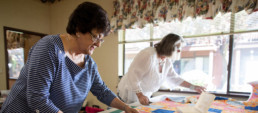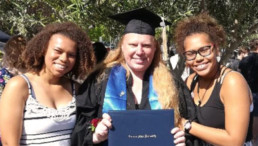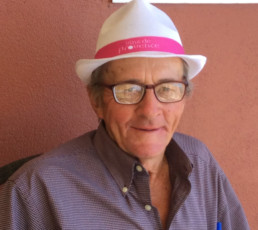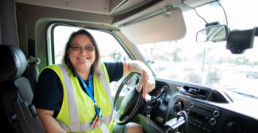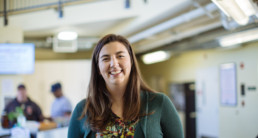25 Years of Warmth
"They don’t necessarily remember that they were living in a shelter, but they know that they love their quilt."
Every toddler needs a security blanket, their own little “lovey.” At COTS, those blankets are handmade, one-of-a-kind quilts made by the volunteers from Quilters for COTS.
“When I see a toddler snuggling under their quilt, using it as a tent, or wrapping up their stuffed animal, I think of all the hands that touched each piece of fabric, all the love that went into it,” says Case Manager Debbie Robbins. “I know of several kids who received quilts years ago and still cherish them. They don’t necessarily remember that they were living in a shelter, but they know that they love their quilt.”
It all started back in 1993, when some friends came together to make gifts for the kids at COTS. They’ve since expanded their mission to include our adult clients and the fire survivors we’re helping from our Santa Rosa offices. To date, they’ve provided almost 3,500 quilts!
“There are a lot of steps to putting together a quilt,” says Quilter Coordinator Ellie O’Connor. “Some of it we do on our own at home. But we get together at least once a month to put them together. All told, it takes between six and eight hours to put together one quilt.”
They rely on donations of fabric and batting—the more colorful the better. COTS has strict rules about privacy and confidentiality, so the quilters never know who gets a particular quilt. And that’s okay with them.
“I just think, ‘People will be warmer,’” says quilter Lillian Ruggles. “How beautiful is that? That’s all I need.”
To donate materials or to get involved, please contact Ellie at [email protected] or 707.763.0283.
COTS Milestones
“Great things are done by a series of small things brought together.”
-Vincent Van Gogh
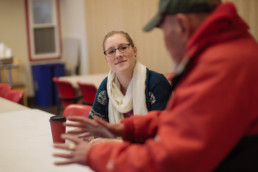
COTS in Rohnert Park
A partnership with City of Rohnert Park will allow us to rapidly re-house 53 individuals this year.
Respite Revamped
Opening in October, this 7-bed recovery and recuperation unit at the Mary Isaak Center will reduce lengthy hospital stays for patients who are homeless.
COTS Opens in Santa Rosa
Laure Reichek Housing Hub will assist 572 individuals impacted by the fires to find and keep housing.
Diversion Takes Burden Off of Shelter
COTS Diversion Specialist assists individuals who are homeless but do not need shelter services to resolve housing-related issues.
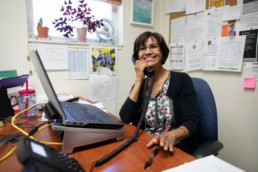

New CEO
Chuck Fernandez begins his tenure on October 15. Chuck has been CEO of Catholic Charities of the East Bay in Oakland for four years, assuming that role after a 3-year stint as executive director of Catholic Charities of the Diocese of Santa Rosa. We are thrilled to have him join COTS.
We asked former shelter guests,
“What’s it like living in your new home?”
“I have the confidence to reach out and become a leader in my neighborhood.”
“The expiration date is removed, removing the stress of having to make life changes while at the same time figuring out where to go next. In a shelter, your kids’ friends have to drop them off a block or The sun came shining through.” two away so they won’t know they live in ‘that place.’ Having a home removes the shame and embarrassment.”
“All that hard work paid off. The sun came shining through.”
Wendy's story
Wendy left COTS two and half years ago, after coming up on a wait list for a local affordable housing complex. She’s been busy! While working and raising her teenage kids, she earned her BA in Psychology last year from SSU.
She now works two jobs: freelancing as a massage therapist (the job with which she put herself through school) and working in her new field as a behavioral technician, working one-on-one with an autistic teenager, helping him develop school and life skills.
She credits COTS with helping her develop the habit of saving. “I grew up with a mother who spent money she didn’t have. I had to learn to do things a different way. If I hadn’t saved money at COTS I wouldn’t have been able to move to my apartment. Things are still tight, but I have a savings cushion that I’m really proud of.”
She’s also really proud of her kids—for their academic successes but also because of their maturity and consideration. “Living so close, we became close. They notice if I need help. They’ll cook and clean. They’ve stayed out of trouble and they have good heads on their shoulders.”
Wendy's advice: “Everybody needs help at some point in their life. For everybody, that help comes at different times and from different people. Let go of any stigma around that. If you don’t, you’ll be over- whelmed by your problems and you won’t get to where you want to go.”
Melvin's story
Melvin spent 30 years homeless, mostly avoiding shelters because of violence he’d witnessed in them. When he came to Petaluma in 2013, people told him about COTS, and he gave shelter another try.
While here, he felt safe, and he worked with COTS Benefits Advocate Barbara Pieper on a disability claim. Sadly, that application was unsuccessful. So, he unrolled his sleeping bag and started camping again. But Barbara saw him downtown one day and asked him to try again. He worked with Barbara on an appeal—this time, successfully.
He’s now in our Permanent Supportive Housing program, a program for adults with disabilities. He’s safe and secure, and he has the help of Kathleen Sinnott, a COTS Case Manager, who meets with him every week, helping him stay organized in his financial life, his home life and his social life. Melvin spends his free time at the Senior Center and the library, with frequent trips to Santa Rosa for errands.
Melvin's advice: “Volunteering at COTS, being involved, helped me stay busy and feel better.”
Danielle's story
Danielle and her two daughters moved into housing three years ago with help from COTS. Since our assistance ended, Danielle is doing great, winning recognition at her job with Petaluma Paratransit and helping her kids thrive.
“I feel very zen here. We have two bedrooms, one bathroom and a bird. For the kids
to have stability, that’s the most important thing.” She adds, “I’ve gone from everything I own fitting in a backpack and riding a bike that someone gave me to paying our rent, supporting my kids and handling a car loan. I have a savings account. My kids have savings accounts! It’s a struggle, but it feels good every month to be able to say, ‘I pay that cable bill, I bought that car!”
Danielle's advice: “You’re going to doubt yourself. Keep trying anyway.”
Danielle spent over a decade homeless. For more about Danielle and her story, come to The COTS Hour on November 13 (cotshour.org).
What comes after housing first
Emily Quig leads the support team for our housing programs— a team that’s working harder than ever since the 2017 fires—and a team whose results include housing retention rates of over 90 percent.
What do you and your staff provide?
We serve such a diverse group of people throughout the county, so we really provide a continuum of support. For people who are severely disabled, we can provide safe housing and intensive services. Other people may need a little help with security deposit and a few months’ rent. Maybe they could benefit from some coaching on how to prioritize their savings and how to make a compelling case to a landlord. Maybe they want some help finding a better job, securing childcare, applying for school— whatever they need to move forward and make it more likely that they’ll be able to sustain their housing on their own. Others might need a shared housing situation—that’s generally one of the most affordable options for people.
I’m constantly inspired by our staff members who are unfailingly supportive. And, more than ever, I’m inspired by the people we’re serving.
The housing market is so crowded and so competitive. It takes such determination to find housing. And then to be able to keep that housing is remarkable.
Who are some of the people you’re helping in the Santa Rosa office?
We’re encountering so many people who didn’t necessarily lose their homes immediately when the fires happened. Some lost their housing later, when landlords decided to move family members or friends in. Or maybe they’re just priced out or are having a hard time competing for a rental with some of the displaced homeowners.
More than ever, I’m inspired by the people we’re serving.
What difference did the fires make to your work?
I think the impact is twofold. First, thanks to the huge outpouring of community support after the fires, we have the resources to help many more people. We’ve opened an office in Santa Rosa to help those people made homeless by the fires get back in housing and we’re doing great in that effort.
Second, we’ve always encouraged people to be open and flexible in their housing searches but since the fires, it hasn’t been a hard sell. People know the conditions on the ground. They’re much less likely to hold out for that perfect unit. They grab hold of what’s available—whether that’s sharing a house or even a room with others, moving out of county, or taking a job that includes housing. Our funding is flexible enough that we can help make nontraditional solutions work.
We’re seeing direct evidence of how many people were secondary victims of the fires. That makes me so grateful that this community stepped up so powerfully and that our funders were adamant that this recovery should belong to everybody.
